Development of an individualised primary care program for acute low back pain using a hybrid co-design framework
Malene Ahern A * , Catherine M. Dean B , Blake F. Dear C , Simon M. Willcock D and Julia M. Hush B
A * , Catherine M. Dean B , Blake F. Dear C , Simon M. Willcock D and Julia M. Hush B
A Department of Psychology, Faculty of Medicine, Health and Human Sciences, Australian Hearing Hub, Level 2 and Level 3, 16 University Avenue, Macquarie University, Sydney, NSW 2109, Australia.
B Department of Health Sciences, Faculty of Medicine, Health and Human Sciences, Ground Floor, 75 Talavera Road, Macquarie University, Sydney, NSW 2109, Australia.
C Department of Psychology, Macquarie University, Sydney, NSW 2109, Australia.
D Macquarie University Health Sciences Centre, 2 Technology Place, Macquarie Park, Sydney, NSW 2109, Australia.
Australian Journal of Primary Health 28(5) 428-443 https://doi.org/10.1071/PY21206
Submitted: 23 August 2021 Accepted: 8 March 2022 Published: 5 September 2022
© 2022 The Author(s) (or their employer(s)). Published by CSIRO Publishing on behalf of La Trobe University. This is an open access article distributed under the Creative Commons Attribution-NonCommercial-NoDerivatives 4.0 International License (CC BY-NC-ND)
Abstract
Background: Low back pain is the leading worldwide cause of years lost to disability and the problem is worsening. This paper describes and demonstrates the scholarly development and contextual refinement of a primary care program for acute low back pain in Sydney, Australia.
Methods: Hybrid theoretical frameworks were applied, and co-design was used to contextualise the program to the local healthcare setting.
Results: The program was developed in four stages. In stage 1, the scientific evidence about management of acute low back pain in primary care was examined. In stage 2, stakeholders (patients and clinicians) were consulted in nationwide surveys. Data from stages 1 and 2 were used to design an initial version of the program, called My Back My Plan. Stage 3 involved the contextual refinement of the program to the local setting, MQ Health Primary Care. This was achieved by co-design with primary care clinicians and patients who had sought care for low back pain at MQ Health Primary Care clinics. In stage 4, a panel of Australian experts on clinical care for low back pain reviewed the contextualised version of My Back My Plan and final amendments were made.
Conclusion: My Back My Plan has been developed using an innovative scholarly approach to intervention development.
Keywords: general practitioners, intervention development, matched care, My Back My Plan, patient education, person-centred, physiotherapists.
Introduction
Low back pain (LBP) affects 70–90% of Australians at some time in their lives (Australian Institute of Health and Welfare 2019), and although many episodes are transient, at least one-third develop chronic pain after seeking primary care for an acute episode (Henschke et al. 2008; Chou and Shekelle 2010). The 2017–18 Australian Bureau of Statistics National Health Survey reveals that about 4 million Australians currently suffer from long-term disability due to LBP (Australian Bureau of Statistics 2018). In fact, LBP is one of the most burdensome non-fatal conditions in Australia and globally (Vos et al. 2020), and the disability burden is steadily rising (March et al. 2014). Recent research has indicated that up to two-thirds of individuals experienced recurrence of LBP within 12 months after recovery from the acute LBP episode (Machado et al. 2017; da silva et al. 2019). These reported rates of symptom persistence and recurrence suggest that initial LBP episodes may be better described as episodes of a relapsing and remitting disorder with an ‘acute phase’. Furthermore, the high burden of disease from LBP causes great individual suffering and socioeconomic inequality in Australia (Schofield et al. 2012), indicating current primary care management of acute LBP may be inadequate in preventing progression to chronic LBP. Indeed, there is Level 1 evidence (Maher et al. 2017) that common treatments for acute LBP tested in randomised controlled trials fail to achieve clinically worthwhile outcomes.
One explanation for this may be that the complex, multidimensional nature of LBP has been largely neglected in clinical trials, which are commonly designed to evaluate only unimodal treatments (e.g. heat, massage or analgesics); another may be that researchers have rarely designed novel treatments for LBP using scholarly intervention development methodologies, rather selecting treatments from those in current clinical use (Hush 2020). Furthermore, recent research efforts have aimed at overcoming the ‘one size fits all’ treatment approach by investigating outcomes from stepped care, stratification and matched care approaches within clinical trials (Linton et al. 2018). These approaches aim to provide more efficient and cost-effective health care for people with LBP, by providing a level of care that aligns with the clinical profile of the patient, based on assessment findings. These considerations indicate that novel treatment approaches that embrace the complexity of LBP and are designed using appropriate intervention development methods, are needed.
This paper describes and demonstrates the process of developing a scholarly informed and contextually refined primary care program for acute LBP in Sydney, Australia. In this study, an episode of acute LBP was defined as a period of pain of <12 weeks’ duration, not caused by specific or serious pathology, lasting for >24 h and for which health care is sought (de Vet et al. 2002). The development of this program, My Back My Plan, utilised a mixed qualitative and quantitative methodological approach to understand gaps in current research evidence, stakeholder needs, local context needs and using co-design/iterative feedback to develop an intervention. An essential first step when developing a complex health intervention is to review relevant theoretical frameworks and identify empirical evidence (Craig et al. 2008). Theoretical frameworks aim to assist clinicians and researchers when developing a new intervention by clearly defining the relevant barriers and enablers in the design of implementation strategies (Hodder et al. 2016). Common frameworks include intervention mapping (Eldredge et al. 2016), complex intervention development (Craig et al. 2008) and behaviour change wheel (Michie et al. 2011). A systematic mapping review examining how health interventions have been developed in a range of contexts, found that a common practice is to create a hybrid approach adapted to the local context, which can result in more acceptable, feasible and effective outcomes (Croot et al. 2019). Such hybrid approaches may also be more adaptive to dynamic local healthcare systems (O’Cathain et al. 2019). Another important feature in the development of interventions is co-design with relevant stakeholders (such as patients, clinicians, community, researchers), so that local contextual factors are given appropriate consideration, and thereby facilitate tailored solutions for that local healthcare system (Skivington et al. 2018) and improve person-centred care (Viney and Sides 2017).
Therefore, in this study, we used a hybrid development process and user co-design with patients and clinicians to contextualise the program to the healthcare system that was the test site for this project: Macquarie University (MQ) Health Primary Care. This site includes a co-located general practice (GP) service and outpatient physiotherapy (PT) clinic, facilitating interdisciplinary care for LBP patients. Note that in Australia, physiotherapists (PTs) are registered primary healthcare professionals and first contact practitioners. The resultant program was developed specifically for acute LBP and is called My Back My Plan (MBMP). The present paper outlines the development of MBMP, and the accompanying paper (Ahern et al. 2022) describes the feasibility and acceptability trial of MBMP at MQ Health Primary Care.
Methods
The development of MBMP was conducted in four stages (Fig. 1).

|
Stage 1
The initial stage aimed to explore the evidence about management of acute LBP treatment in primary care, and relevant scientific literature on the following aspects of acute LBP care was evaluated: (1) evidence of effectiveness of primary care treatments; (2) stepped, stratified, and matched care approaches; (3) relevant clinical practice guidelines; and (4) person-centred care. Note that evidence examined was available at the time the review was conducted at the start of this project, in 2016. Secondary pre-appraised research (e.g. systematic reviews) where available, was evaluated prior to primary original research.
Stage 2
In this stage, stakeholder consultation was conducted in two studies. The first was a cross-sectional nationwide internet survey of patients who had sought primary care for LBP. The aim of this study was to understand the experiences and needs of Australians who had received treatment for LBP in primary care. The methods of this study are outlined elsewhere (Ahern et al. 2019). The second study was also a cross-sectional nationwide internet survey, but of primary care clinicians. The aim of this study was to identify the practices and perspectives of general practitioners (GPs) and PTs in their management of acute LBP. The methods of this study are also outlined elsewhere (Ahern et al. 2020). Macquarie University Human Research Ethics Committee (Refs: 520170078, 5201800026) approved these studies.
My Back My Plan version 1
A preliminary prototype of MBMP was designed using data from Stages 1 and 2. This included the composition of the healthcare team, the clinical pathway to be employed, the assessment methods to be used, how the treatment streams would be matched to patient needs, and a Patient Booklet.
Stage 3
In this stage of the project, My Back My Plan Version 1 (MBMP Version 1) was contextually refined to the MQ Health Primary Care setting, optimising content and process. This was achieved by co-design with: (1) MQ Health Primary Care clinicians (GPs and PTs); and (2) MQ Health Primary Care LBP patients. Focus groups were held with each of these cohorts in 2018–19 using semi-structured interviews and framework analysis research methodology (Gale et al. 2013). This research was approved by Macquarie University Human Research Ethics Committee (Ref: 5201800370).
MQ Health Primary Care clinicians
Primary care practitioners were eligible for this study if they: (1) were MQ Health Primary Care General GPs or PTs registered by the Australian Health Practitioner Regulation Agency; and (2) had treated patients presenting with acute LBP at least once in the past 12 months; (3) had adequate proficiency in written English; and (4) were an Australian resident. One week prior to each focus group, background material (information about MBMP Version 1) was sent to study participants to review. Three focus groups of 1.5- h duration were conducted at Macquarie University and were audio recorded. After a brief overview of MBMP Version 1, an interview topic guide was used to investigate clinicians’ views about the program and to obtain their feedback to optimise the program. Audio files were transcribed verbatim. Transcripts were checked against audio files for accuracy and were analysed by two members (MA, JMH) of the research team. Framework analysis was used to identify emergent themes related to clinicians’ opinions about MBMP Version 1.
MQ Health Primary Care LBP patients
Patients were eligible for this study if they: (1) received treatment at MQ Health Primary Care for LBP within first 12 weeks of an episode; (2) were able to read, write and speak English; and (3) were aged ≥18 years. Participants were excluded if they had experienced LBP due to serious or specific pathology requiring specialised treatment. Three focus groups of 1.5- h duration were conducted at Macquarie University and were audio recorded. The participants first completed a brief questionnaire to evaluate their experiences of treatment for LBP at MQ Health Primary Care. MBMP Version 1 was explained to the participants and an interview topic guide was used to investigate their views about the program and obtain their feedback to optimise the program, as well as previous care received at MQ Health. Audio files were transcribed verbatim. Transcripts were checked against audio files for accuracy and were analysed by two members (MA, JMH) of the research team. Framework analysis was used to identify emergent themes related to patients’ perceptions of treatment for acute LBP at MQ Health, and opinions about the proposed MBMP program. Data obtained from the questionnaire were analysed using descriptive statistics.
Stage 4
In the final stage, feedback from interdisciplinary primary care clinicians who had specific expertise in LBP was sought about MBMP. This study was an online internet survey conducted in 2019, hosted by Qualtrics (Provo, UT, USA), licensed to Macquarie University. This study was approved by Macquarie University Human Research Ethics Committee (Ref: 5201836676466). Experts were selected based on the following criteria: (1) they had a national or international profile in the field of LBP; (2) they had a significant background of clinical experience in LBP care; and (3) they were a medical practitioner, physiotherapist, psychologist, or pharmacist registered to practice in Australia. The survey was designed to take approximately 15–20 min to complete, and consisted of questions about clinician demographics, their opinions on aspects of the MBMP program (principles, content, personalised care, potential benefits) and overall comments. Single item questions were analysed using descriptive statistics and qualitative responses were analysed by two members (MA, JMH) of the research team. Data were de-identified to ensure confidentiality.
My Back My Plan
The contextualised MQ Health Primary Care version of the MBMP program was finalised using data from Stages 3 and 4.
Results
Stage 1
Effectiveness of primary care treatments
Evidence synthesis of treatment effectiveness for acute LBP (Maher et al. 2017) revealed that: (1) treatments evaluated in clinical trials were predominantly unimodal; (2) a low proportion of the evidence was high quality (based on the Grading of Recommendations Assessment, Development and Evaluation (GRADE) rating (Guyatt et al. 2008)); and (3) of the treatment comparisons evaluated, including pharmacological therapies, bed rest, manual therapies, massage, exercise and acupuncture, the only treatment with evidence for a clinically worthwhile pain reduction was heat therapy; however, this was based on very low-quality evidence. Of treatments for which there was high-quality evidence, most (NSAIDs, paracetamol, and exercise) had very small treatment effects, which are unlikely to be worthwhile to patients (Ferreira et al. 2009).
Stepped, stratified, and matched care
These approaches, summarised in Table 1, aim to achieve more cost-effective health care by providing care that aligns with the patient’s clinical profile, rather than a one-size-fits-all treatment. A benefit of all three approaches in the context of acute LBP is that overtreatment is avoided for low-risk patients; however, additional benefit is gained from stratified and matched care with early screening to specifically identify those at higher risk who would benefit from more comprehensive treatment (Linton et al. 2018). Commonly recommended screening tools for risk stratification include the STarT Back screening tool (SBST) (Hill et al. 2008) and Örebro Musculoskeletal Pain Screening Questionnaire (ÖMPSQ – Short Form) (Linton et al. 2011). There is good evidence of beneficial outcomes in Australian workers with LBP injuries, using the ÖMPSQ for early identification of delayed recovery or return to work (Nicholas et al. 2020). A review of both the ÖMPSQ and SBST for acute LBP in primary care (Karran et al. 2017) found that both instruments have good accuracy at identifying risk of high disability or prolonged absenteeism, although do not perform as well at identifying those at risk of developing chronic pain. This review recommended assessment of additional contextual or prognostic factors, in addition to scores of screening tools, to provide a more comprehensive assessment of patient risk. Although the large body of literature on LBP prognosis is characterised by variable methods and results (Hayden et al. 2008), there are some biological, psychological and social factors that are consistently associated with poor outcome. These include: presence of a compensable injury, negative cognitive beliefs (such as catastrophising), poor general health and co-morbidities as well as other factors such as presence of sciatica, reduced mobility and functional dependence (10 m walk test) and poor relationships with colleagues (Hayden et al. 2008; Middleton et al. 2015). This evidence informed the selection of additional clinical features for clinicians to consider as contextual factors in their patient assessment and identifying the level of risk for developing chronic pain.
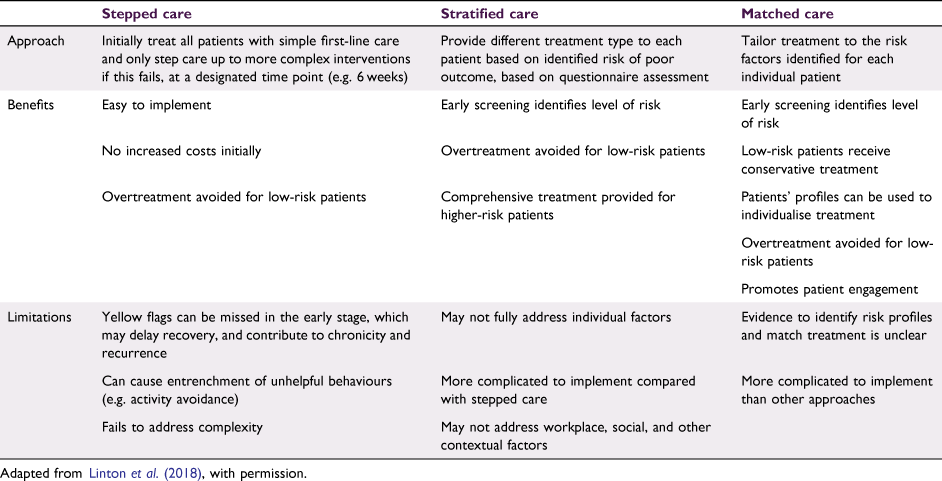
|
Clinical practice guidelines
Three guidelines most relevant to primary care management in Australia for non-specific acute LBP were examined: the 2016 New South Wales Agency of Clinician Innovation Model of Care: Management of People with Acute Low Back Pain (ACI MoC (Australia); NSW Agency for Clinical Innovation 2016), the 2016 National Institute of Health and Care Excellence Low Back Pain and Sciatica in over 16s: Assessment and Management (NICE (UK); National Institute for Health and Care Excellence (NICE) 2016), and the 2017 American College of Physicians Noninvasive Treatments for Acute, Subacute, and Chronic Low Back Pain: A Clinical Practice Guideline From the American College of Physicians (ACP (USA); Qaseem et al. 2017). Recommendations for primary care of acute LBP in these guidelines are summarised in Table 2. Elements of assessment consistently recommended were: diagnostic triage (or identification of serious pathology); psychosocial risk assessment; and avoidance of routine radiological imaging. Regarding treatment, advice to remain active, education about LBP, prognosis, and self-management were commonly recommended; however, guidelines varied in the extent, mode, and content of education. Some recommendations about short-term use of simple analgesics were consistent. Recommendations varied across the guidelines regarding inter-disciplinary care, exercise and adjunct treatments such as spinal manual therapy. Although individualised treatments were recommended, stratification and psychological approaches were only recommended in the ACI MoC and the NICE (UK) guidelines. Pre-determined review times were only recommended in the ACI MoC (Australia). These elements of first-line care for acute LBP were supported in a 2018 review (Almeida et al. 2018) of current international clinical guidelines for LBP.
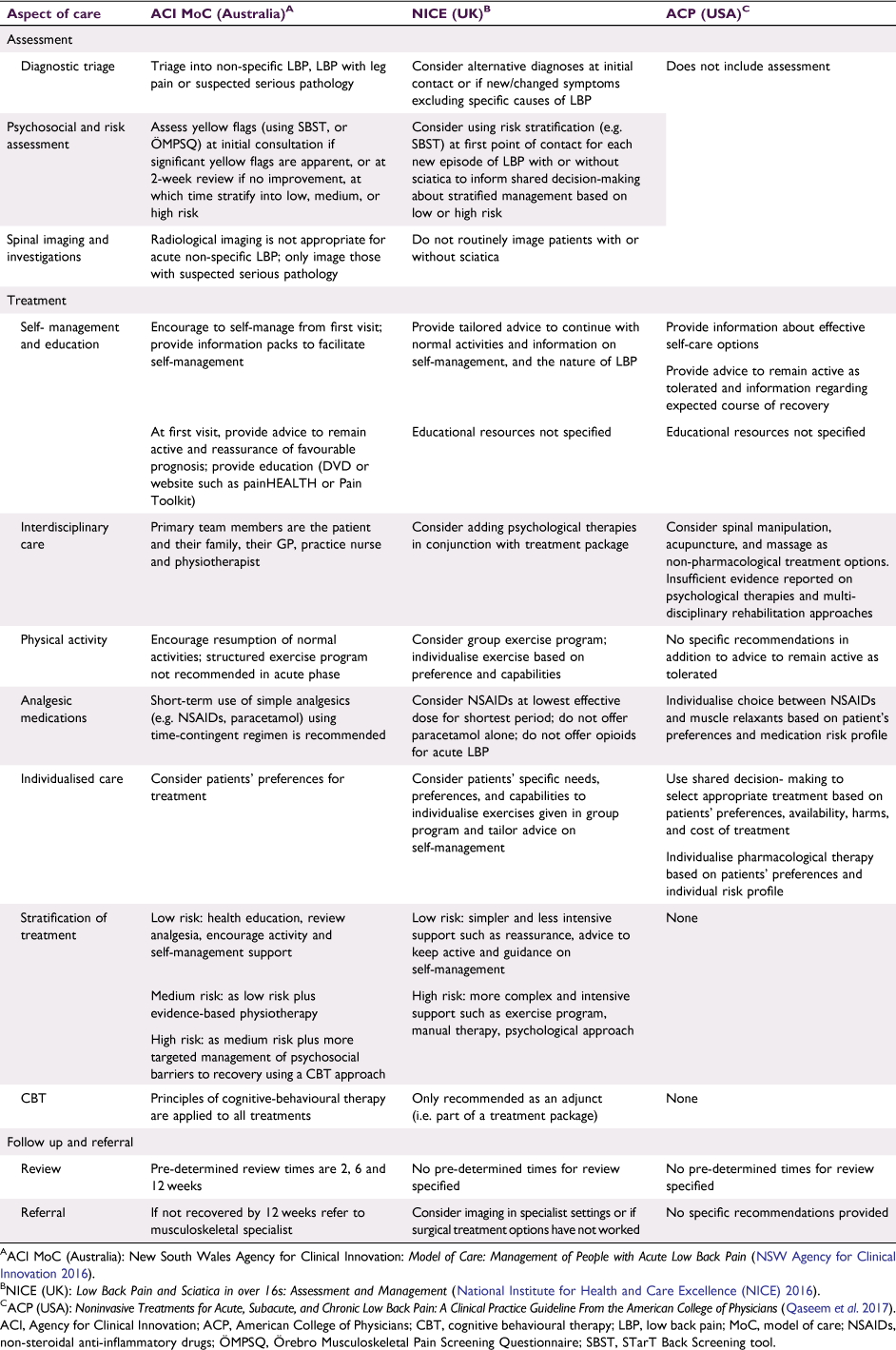
|
Several barriers have been reported to the implementation of LBP guidelines from the perspective of clinicians. These include beliefs regarding the role of guidelines (e.g. that they are highly prescriptive), time constraints, knowledge limitations and perceptions that guidelines can restrict clinical judgment and challenge professional autonomy (Slade et al. 2016).
Person-centred care
A systematic review of clinical practice guidelines recommends that best practice care for musculoskeletal pain is person-centred or patient-centred, defined as ‘care that responds to the individual context of the patient, employs effective communication and uses shared decision-making processes’ (Lin et al. 2020). To achieve a person-centred approach in primary care for LBP, multimodal treatment strategies, selected with the patient using shared decision-making, have been recommended; such individualised treatments may include patient education and reassurance, self-care, pharmacologic and non-pharmacologic therapies, and timely follow up (Shah 2017).
Stage 2
Survey of patients
The full results of this survey have been published previously (Ahern et al. 2019). A total of 426 Australians completed the survey with a response rate of survey completion of 50%. Participants reported seeking primary care for LBP not only for pain relief, but to help with activities and participating in social roles, as well as to improve quality of life and mood. Participants consulted multiple healthcare practitioners for health care, with more than one-quarter of participants consulting four to eight different types of practitioners; the clinicians most commonly consulted were general practitioners and physiotherapists; and used numerous treatment modalities. Only half reported they received education and a very low proportion reported receiving care consistent with guideline-based advice. The level of satisfaction with care was below moderate for 42% of respondents. Participants reported that they want LBP care to be more person-centred and better tailored to their needs; they also reported wanting more education, particularly about prevention of future episodes and self-management (Ahern et al. 2019).
Survey of clinicians
The full results of this survey have been published previously (Ahern et al. 2020). Two hundred primary care practitioners (72% PTs and 28% GPs) from all States and Territories of Australia completed the survey. Most primary care practitioners were familiar with clinical guidelines for acute LBP management and reported they typically delivered many core components of guideline-based care, including education, advice about favourable prognosis, encouraging activity and self-management and discouraging prolonged bed rest. Deviations from guideline-based care were common, including providing some medications, passive therapies and referring for radiological imaging. Overall, most Australian primary care clinicians in this sample were aware of LBP guidelines and typically implement care that is consistent with guideline-based recommendations. Divergences from these guidelines may indicate that primary care practitioners were delivering evidence-based and person-centred care that integrates clinicians’ judgement with patients’ preferences and guideline-based evidence.
My Back My Plan version 1
The first version of the MBMP program (MBMP Version 1) was designed by integrating evidence about primary care management of acute LBP (Table 3) and the outcomes from the stakeholder consultation studies (Table 4). The principles and core elements of MBMP Version 1 program are listed in Table 5, and the program is briefly outlined below.
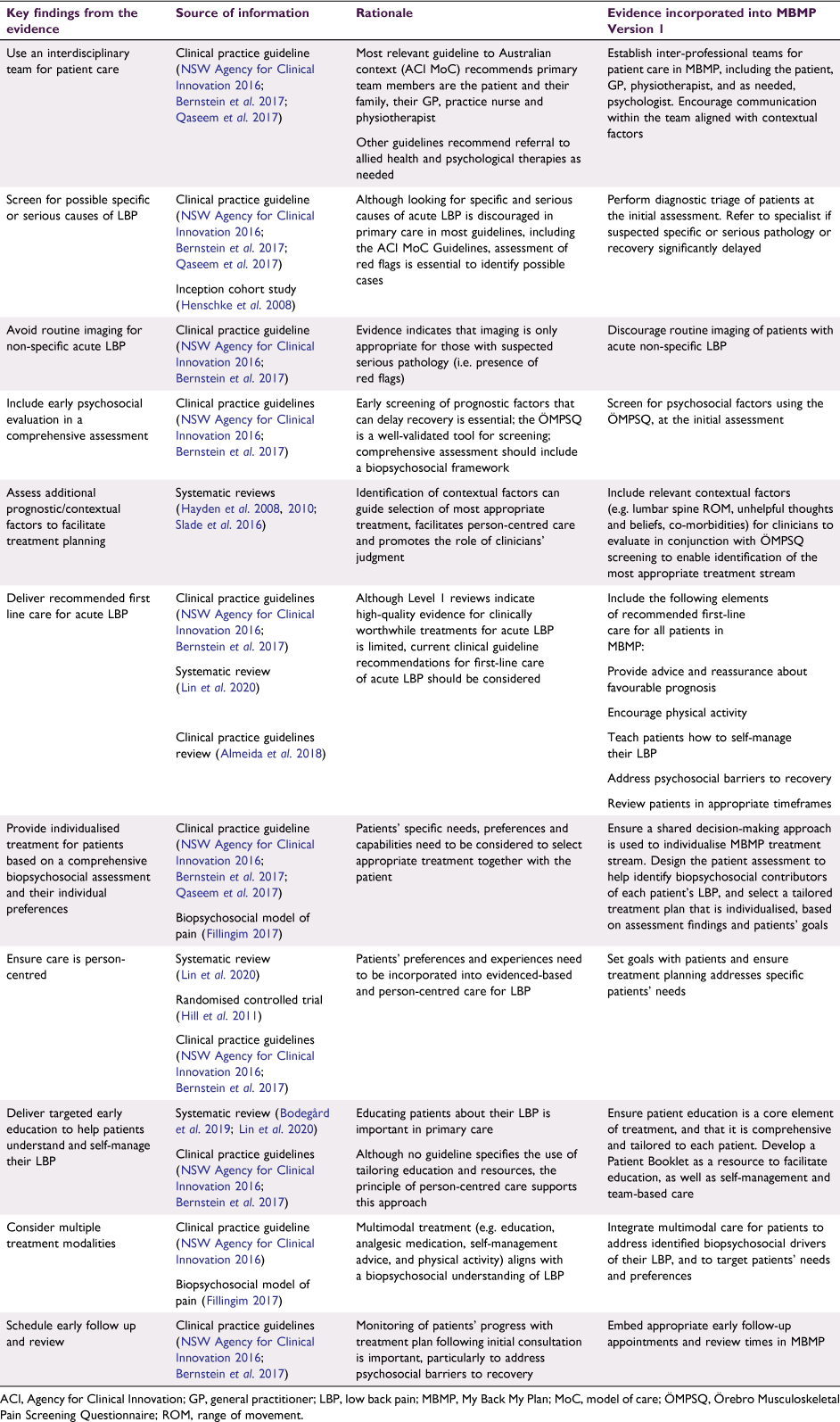
|
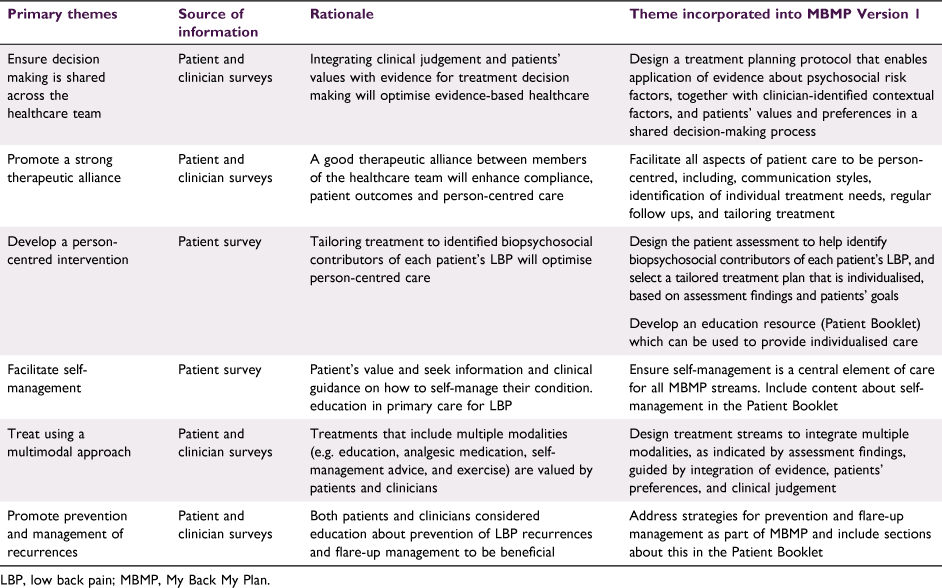
|
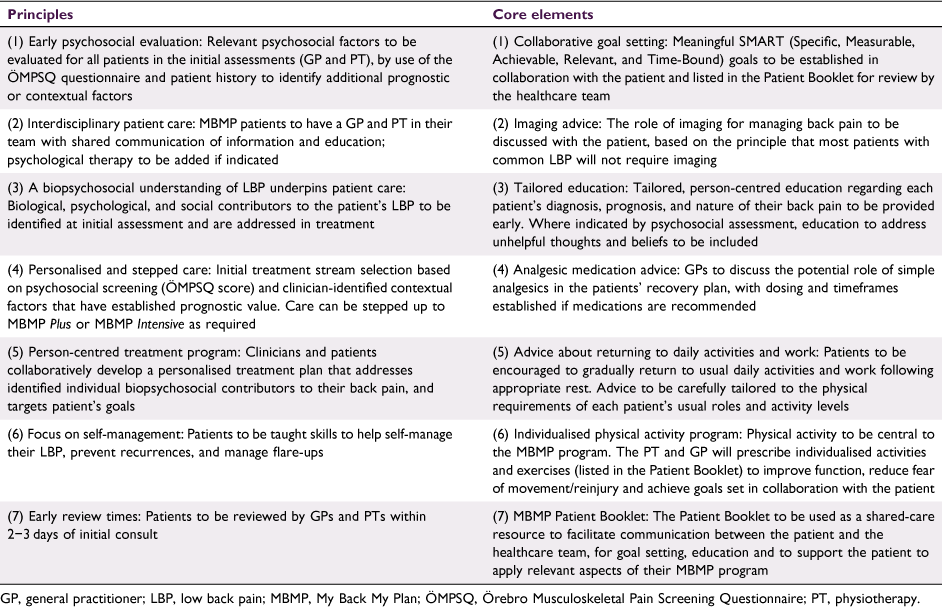
|
Clinical pathway
Patients could access MBMP through initial consultation with a GP or PT.
Patient assessment
The initial assessment would include diagnostic triage to screen out patients with possible serious or specific causes of LBP, a comprehensive patient history to understand the biopsychosocial contributors to the presenting problem, identify the patient’s goals and preferences for treatment; conduct a thorough physical examination (including a neurological exam if indicated) to assess lumbar mobility, physical function and fear avoidance behaviours; routine referral for radiological imaging was avoided.
Treatment streams
Three treatment streams were developed to provide stepped care for patients: MBMP Standard, MBMP Plus, and MBMP Intensive (Table 6). All streams were based on the principles of inter-professional patient management, delivery of recommended first-line care, and individualised, person-centred care. The optimal treatment stream would be identified by integrating findings from the patient assessment, evaluation of the ÖMPSQ score and additional contextual factors (co-morbidities, compensable injury, LBP recurrence, lumbar spine range of movement, gait speed, and unhelpful thoughts and beliefs). Each stream differed with respect to the number and type of health professionals involved, and the frequency and number of consultations and complexity of care required.
Patient Booklet
An A4 Patient Booklet was designed to: (1) facilitate communication between all members of the healthcare team; (2) serve as an interactive educational resource; (3) facilitate shared decision-making about treatment; (4) assist the patient to set treatment goals; (5) prescribe activities; and (6) facilitate self-management, including prevention of future episodes of LBP and flare-up management. The Patient Booklet was to be given to the patient at the first assessment, and relevant sections explained regarding diagnosis and prognosis. The booklet consisted of four sections: Understand my back pain, Reassure myself, Move well, and My Recovery plan. An over-arching aspect of the booklet design was to enable content to be tailored to patients, and to support person-centred care. An educational graphic designer assisted with development of the booklet.
Stage 3
MQ Health Primary Care clinicians
Thirteen MQ Health Primary Care participants were recruited to the focus groups; eight GPs, four PTs and one practice manager. In a pre-focus group survey completed by clinicians, the majority (85%) agreed or strongly agreed that a new clinical treatment model for acute LBP was needed. Most clinicians (92%) agreed the MBMP program was feasible to implement in clinical practice. All clinicians agreed (58%) or strongly agreed (42%) that MBMP would be beneficial for LBP patients in primary care.
MQ Health LBP patients
Fourteen participants who had previously sought care at MQ Health Primary Care GP or PT clinics for treatment of acute LBP were recruited to the focus groups. Slightly more than half (57%) were female, and the mean age was 44 years. Participants had received LBP care from MQ Health GPs and PTs (79 and 50%, respectively). Almost half (42%) of participants reported they found treatment extremely or very beneficial for their recovery from LBP. Overall, half of the participants (50%) were extremely or very satisfied with their previous care at MQ Health. Feedback on the proposed MBMP Version 1 included consideration of costs of seeking care, benefits of having a patient booklet resource as an educational tool, and optimisation of the useability of the booklet by adding sections on long-term management and self-pacing.
Data analysis from the focus groups of both cohorts enabled contextual refinement of MBMP as summarised in Table 7. Each element of the program was either affirmed by the focus groups or enhanced following amendment.
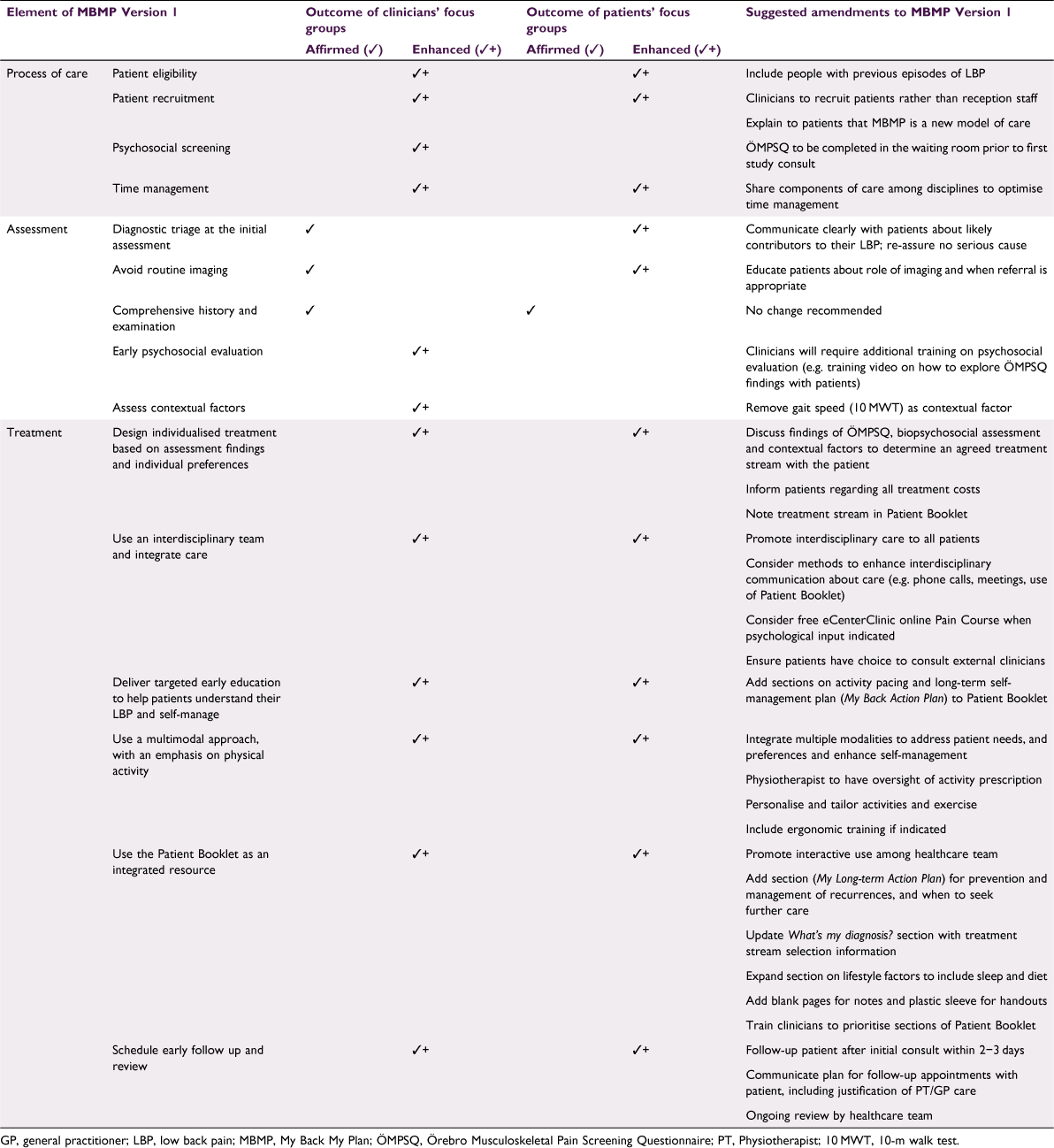
|
Stage 4
Seventeen experts (89% of those invited) completed the survey and 94% were primary care clinicians, with a mean (SD) of 22 (10) years clinical experience. Disciplines included physiotherapy (53%), medicine (24%), psychology (18%) and pharmacy (6%). Regarding the principles of MBMP, most participants (>85%) rated management based on identified biopsychosocial factors, person-centred treatment with individualised care, and the focus on self-management as very relevant. Approximately two-thirds rated personalised care and early psychosocial evaluation for all patients as very relevant. Interdisciplinary patient care for all patients was rated as somewhat or very relevant by 76% the participants. Regarding the core elements of MBMP, most participants (>85%) rated tailored education, advice about returning to daily activities and work, individualised physical activity program and imaging advice as very relevant. More than half of the participants rated collaborative goal-setting and analgesic medication advice as very relevant.
Overall, the interdisciplinary experts surveyed in this study affirmed most of the key aspects of MBMP for MQ Health Primary Care (Table 8). Based on their feedback, the following changes were made to enhance the program.
Stepped care was replaced with matched care.
ÖMPSQ cut-off scores for the MBMP program streams were adjusted to: MBMP Standard < 40; MBMP Plus 40−65; and MBMP Intensive > 65.
A shared decision-making approach was implemented to select the most appropriate treatment stream.
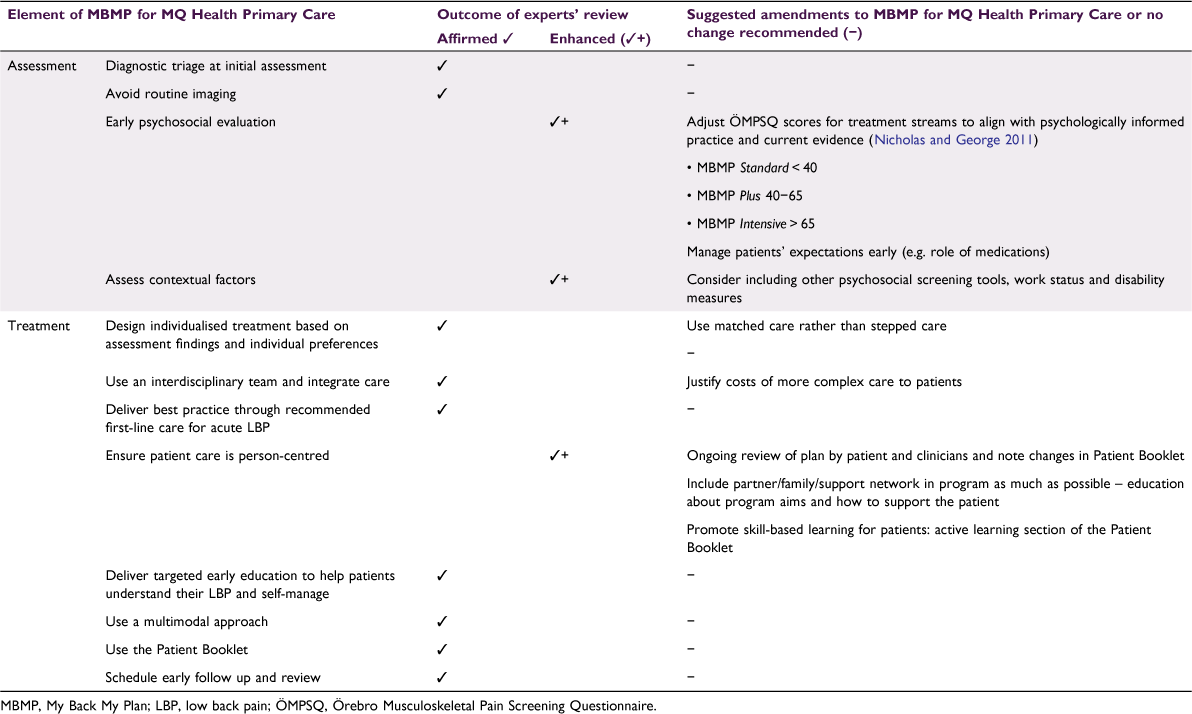
|
MBMP final version 1
Amendments to MBMP following Stages 3 and 4 resulted in the final version of MBMP contextualised for MQ Health Primary Care. The only adjustment to the principles and core elements (Table 5) was to change Personalised and stepped care (principle 4) to Personalised and matched care. The revised treatment streams, including updated ÖMPSQ scores, contextual factors, and matched care, are shown in Fig. 2. A brief training video was made available for clinicians on assessment of psychosocial factors, using the completed ÖMPSQ as a resource. Other amendments made are listed in Tables 7, 8. The final Patient Booklet is available in FigShare (https://doi.org/10.25949/20488191.v1).
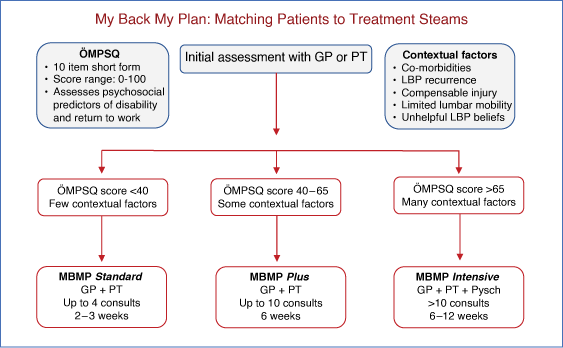
|
Discussion
The purpose of this paper was to describe and demonstrate the scholarly co-design and contextual refinement of a primary care program for people with acute LBP. The development of this program, My Back My Plan, was founded on empirical evidence and theory and included consultation with key stakeholders, namely primary care clinicians and people seeking care from GPs and PTs for LBP. Co-design methods were applied to contextualise My Back My Plan for MQ Health Primary Care, and the program was reviewed by a national panel of experts. A limitation of the development process is that the program was contextualised to a single primary care setting. Thus, there are other healthcare professionals (e.g. pharmacists) and factors that might need to be considered in other contexts if this and similar programs are to be used in different or across multiple settings. Nevertheless, the principles of scholarly development and contextual refinement of the program outlined in this paper may assist others to develop programs to suit their local contexts. The next stage of this project was to test the clinician-rated feasibility and patient-rated acceptability of My Back My Plan. This feasibility and acceptability trial is reported in an accompanying paper (Ahern et al. 2022).
Data availability
The data that support this study are available in the article and in FigShare at https://doi.org/10.25949/20488191.v1.
Conflicts of interest
The authors declare no conflicts of interest.
Declaration of funding
MA was funded by a Macquarie University Research Training Program full-time PhD scholarship. BFD was supported by a National Health and Medical Research Emerging Leadership Fellowship and is part of a team funded by the Australian Federal Government to develop and provide a free national online assessment and treatment service, the MindSpot Clinic, for Australians with anxiety and depression. The sources of support to MA and BFD had no involvement in the decision to submit the final manuscript for publication.
Acknowledgements
The authors thank the patients who participated in this study, as well as the staff of the MQ Health General Practice Clinic and Physiotherapy Clinic.
References
Ahern M, Dean CM, Dear BF, Willcock SM, Hush JM (2019) The experiences and needs of people seeking primary care for low-back pain in Australia. Pain Reports 4, e756| The experiences and needs of people seeking primary care for low-back pain in Australia.Crossref | GoogleScholarGoogle Scholar |
Ahern M, Dean CM, Dear BF, Willcock SM, Hush JM (2020) Management of acute low back pain: the practices and perspectives of primary care clinicians in Australia. Australian Journal of Primary Health 26, 256–264.
| Management of acute low back pain: the practices and perspectives of primary care clinicians in Australia.Crossref | GoogleScholarGoogle Scholar |
Ahern M, Dean CM, Dear BF, Willcock SM, Hush JM (2022) My Back My Plan is a feasible and acceptable individualised program for acute low back pain in primary care. Australian Journal of Primary Health.
| My Back My Plan is a feasible and acceptable individualised program for acute low back pain in primary care.Crossref | GoogleScholarGoogle Scholar |
Almeida M, Saragiotto B, Richards B, Maher CG (2018) Primary care management of non‐specific low back pain: key messages from recent clinical guidelines. Medical Journal of Australia 208, 272–275.
| Primary care management of non‐specific low back pain: key messages from recent clinical guidelines.Crossref | GoogleScholarGoogle Scholar |
Australian Bureau of Statistics (2018) National Health Survey: First Results, 2017–18. Cat. no. 4364.0.55.001. (Commonwealth of Australia: Canberra, ACT, Australia) Available at https://www.abs.gov.au/statistics/health/health-conditions-and-risks/national-health-survey-first-results/latest-release [Verified 7 February 2021]
Australian Institute of Health and Welfare (2019) Back problems. Cat. no. PHE231. (AIHW: Canberra, ACT, Australia) Available at https://www.aihw.gov.au/reports/chronic-musculoskeletal-conditions/backproblems/contents/what-are-back-problems [Verified 7 February 2021]
Bernstein IA, Malik Q, Carville S, Ward S (2017) Low back pain and sciatica: summary of NICE guidance. BMJ 356, i6748
| Low back pain and sciatica: summary of NICE guidance.Crossref | GoogleScholarGoogle Scholar |
Bodegård H, Helgesson G, Juth N, Olsson D, Lynøe N (2019) Challenges to patient centredness – a comparison of patient and doctor experiences from primary care. BMC Family Practice 20, 83
| Challenges to patient centredness – a comparison of patient and doctor experiences from primary care.Crossref | GoogleScholarGoogle Scholar |
Chou R, Shekelle P (2010) Will this patient develop persistent disabling low back pain? JAMA 303, 1295–1302.
| Will this patient develop persistent disabling low back pain?Crossref | GoogleScholarGoogle Scholar |
Craig P, Dieppe P, Macintyre S, Michie S, Nazareth I, Petticrew M (2008) Developing and evaluating complex interventions: the new Medical Research Council guidance. BMJ 337, a1655
| Developing and evaluating complex interventions: the new Medical Research Council guidance.Crossref | GoogleScholarGoogle Scholar |
Croot L, O’Cathain A, Sworn K, Yardley L, Turner K, Duncan E, Hoddinott P (2019) Developing interventions to improve health: a systematic mapping review of international practice between 2015 and 2016. Pilot and Feasibility Studies 5, 127
| Developing interventions to improve health: a systematic mapping review of international practice between 2015 and 2016.Crossref | GoogleScholarGoogle Scholar |
da Silva T, Mills K, Brown BT, Pocovi N, de Campos T, Maher C, Hancock MJ (2019) Recurrence of low back pain iscommon: a prospective inception cohort study. Journal of Physiotherapy 65, 159–165.
| Recurrence of low back pain iscommon: a prospective inception cohort study.Crossref | GoogleScholarGoogle Scholar |
de Vet HC, Heymans MW, Dunn KM, Pope DP, van der Beek AJ, Macfarlane GJ, Bouter LM, Croft PR (2002) Episodes of low back pain: a proposal foruniform definitions to be used in research. Spine (Phila Pa 1976) 2409–2416.
| Episodes of low back pain: a proposal foruniform definitions to be used in research.Crossref | GoogleScholarGoogle Scholar |
Eldredge LKB, Markham CM, Ruiter RA, Fernández ME, Kok G, Parcel GS (2016) ‘Planning health promotion programs: an intervention mapping approach.’ (Jossey-Bass Inc.: San Francisco)
Ferreira ML, Ferreira PH, Herbert RD, Latimer J (2009) People with low back pain typically need to feel ‘much better’ to consider intervention worthwhile: an observational study. Australian Journal of Physiotherapy 55, 123–127.
| People with low back pain typically need to feel ‘much better’ to consider intervention worthwhile: an observational study.Crossref | GoogleScholarGoogle Scholar |
Fillingim RB (2017) Individual differences in pain: understanding the mosaic that makes pain personal. Pain 158, S11–S18.
| Individual differences in pain: understanding the mosaic that makes pain personal.Crossref | GoogleScholarGoogle Scholar |
Gale NK, Heath G, Cameron E, Rashid S, Redwood S (2013) Using the framework method for the analysis of qualitative data in multi-disciplinary health research. BMC Medical Research Methodology 13, 117
| Using the framework method for the analysis of qualitative data in multi-disciplinary health research.Crossref | GoogleScholarGoogle Scholar |
Guyatt GH, Oxman AD, Vist GE, Kunz R, Falck-Ytter Y, Alonso-Coello P, Schünemann HJ (2008) GRADE: an emerging consensus on rating quality of evidence and strength of recommendations. BMJ (Clinical Research ed.) 336, 924–926.
| GRADE: an emerging consensus on rating quality of evidence and strength of recommendations.Crossref | GoogleScholarGoogle Scholar |
Hayden JA, Côté P, Steenstra IA, Bombardier C (2008) Identifying phases of investigation helps planning, appraising, and applying the results of explanatory prognosis studies. Journal of Clinical Epidemiology 61, 552–560.
| Identifying phases of investigation helps planning, appraising, and applying the results of explanatory prognosis studies.Crossref | GoogleScholarGoogle Scholar |
Hayden JA, Dunn KM, van der Windt DA, Shaw WS (2010) What is the prognosis of back pain? Best Practice & Research Clinical Rheumatology 24, 167–179.
| What is the prognosis of back pain?Crossref | GoogleScholarGoogle Scholar |
Henschke N, Maher CG, Refshauge KM, Herbert RD, Cumming RG, Bleasel J, York J, Das A, McAuley JH (2008) Prognosis in patients with recent onset low back pain in Australian primary care: inception cohort study. BMJ 337, a171
| Prognosis in patients with recent onset low back pain in Australian primary care: inception cohort study.Crossref | GoogleScholarGoogle Scholar |
Hill JC, Dunn KM, Lewis M, Mullis R, Main CJ, Foster NE, Hay EM (2008) A primary care back pain screening tool: identifying patient subgroups for initial treatment. Arthritis Care & Research: Official Journal of the American College of Rheumatology 59, 632–641.
| A primary care back pain screening tool: identifying patient subgroups for initial treatment.Crossref | GoogleScholarGoogle Scholar |
Hill JC, Whitehurst DG, Lewis M, Bryan S, Dunn KM, Foster NE, Konstantinou K, Main CJ, Mason E, Somerville S (2011) Comparison of stratified primary care management for low back pain with current best practice (STarT Back): a randomised controlled trial. The Lancet 378, 1560–1571.
| Comparison of stratified primary care management for low back pain with current best practice (STarT Back): a randomised controlled trial.Crossref | GoogleScholarGoogle Scholar |
Hodder RK, Wolfenden L, Kamper SJ, Lee H, Williams A, O'Brien KM, Williams CM (2016) Developing implementation science to improve the translation of research to address low back pain: a critical review. Best Practice & Research Clinical Rheumatology 30, 1050–1073.
| Developing implementation science to improve the translation of research to address low back pain: a critical review.Crossref | GoogleScholarGoogle Scholar |
Hush JM (2020) Low back pain: it is time to embrace complexity. Pain 161, 2248–2251.
| Low back pain: it is time to embrace complexity.Crossref | GoogleScholarGoogle Scholar |
Karran EL, McAuley JH, Traeger AC, Hillier SL, Grabherr L, Russek LN, Moseley GL (2017) Can screening instruments accurately determine poor outcome risk in adults with recent onset low back pain? A systematic review and meta-analysis. BMC Medicine 15, 13
| Can screening instruments accurately determine poor outcome risk in adults with recent onset low back pain? A systematic review and meta-analysis.Crossref | GoogleScholarGoogle Scholar |
Lin I, Wiles L, Waller R, Goucke R, Nagree Y, Gibberd M, Straker L, Maher CG, O’Sullivan PPB (2020) What does best practice care for musculoskeletal pain look like? Eleven consistent recommendations from high-quality clinical practice guidelines: systematic review. British Journal of Sports Medicine 54, 79
| What does best practice care for musculoskeletal pain look like? Eleven consistent recommendations from high-quality clinical practice guidelines: systematic review.Crossref | GoogleScholarGoogle Scholar |
Linton SJ, Nicholas M, MacDonald S (2011) Development of a short form of the Orebro Musculoskeletal Pain Screening Questionnaire. Spine (Phila Pa 1976) 36, 1891–1895.
| Development of a short form of the Orebro Musculoskeletal Pain Screening Questionnaire.Crossref | GoogleScholarGoogle Scholar |
Linton SJ, Nicholas M, Shaw W (2018) Why wait to address high-risk cases of acute low back pain? A comparison of stepped, stratified, and matched care. Pain 159, 2437–2441.
| Why wait to address high-risk cases of acute low back pain? A comparison of stepped, stratified, and matched care.Crossref | GoogleScholarGoogle Scholar |
Machado GC, Maher CG, Ferreira PH, Latimer J, Koes BW, Steffens D, Ferreira ML (2017) Can recurrence after an acute episode of low back pain be predicted? Physical Therapy 97, 889–895.
| Can recurrence after an acute episode of low back pain be predicted?Crossref | GoogleScholarGoogle Scholar |
Maher C, Underwood M, Buchbinder R (2017) Non-specific low back pain. The Lancet 389, 736–747.
| Non-specific low back pain.Crossref | GoogleScholarGoogle Scholar |
March L, Smith EUR, Hoy DG, Cross MJ, Sanchez-Riera L, Blyth F, Buchbinder R, Vos T, Woolf AD (2014) Burden of disability due to musculoskeletal (MSK) disorders. Best Practice & Research Clinical Rheumatology 28, 353–366.
| Burden of disability due to musculoskeletal (MSK) disorders.Crossref | GoogleScholarGoogle Scholar |
Michie S, van Stralen MM, West R (2011) The behaviour change wheel: A new method for characterising and designing behaviour change interventions. Implementation Science 6, 42
| The behaviour change wheel: A new method for characterising and designing behaviour change interventions.Crossref | GoogleScholarGoogle Scholar |
Middleton A, Fritz SL, Lusardi M (2015) Walking speed: the functional vital sign. Journal of Aging and Physical Activity 23, 314–322.
| Walking speed: the functional vital sign.Crossref | GoogleScholarGoogle Scholar |
National Institute for Health and Care Excellence (NICE) (2016) Low Back Pain and Sciatica in over 16s: Assessment and Management. Available at https://www.nice.org.uk/guidance/ng59 [Verified 7 February 2021]
NSW Agency for Clinical Innovation (2016) Model of Care: Management of People with Acute Low Back Pain. (Agency for Clinical Innovation: Sydney, NSW, Australia) Available at https://www.aci.health.nsw.gov.au/__data/assets/pdf_file/0007/336688/acute-low-back-pain-moc.pdf
Nicholas MK, George SZ (2011) Psychologically informed interventions for low back pain: an update for physical therapists. Physical Therapy 91, 765–776.
| Psychologically informed interventions for low back pain: an update for physical therapists.Crossref | GoogleScholarGoogle Scholar |
Nicholas MK, Costa DSJ, Linton SJ, Main CJ, Shaw WS, Pearce G, Gleeson M, Pinto RZ, Blyth FM, McAuley JH, Smeets RJEM, McGarity A (2020) Implementation of early intervention protocol in Australia for ‘high risk’ injured workers is associated with fewer lost work days over 2 years than usual (stepped) care. Journal of Occupational Rehabilitation 30, 93–104.
| Implementation of early intervention protocol in Australia for ‘high risk’ injured workers is associated with fewer lost work days over 2 years than usual (stepped) care.Crossref | GoogleScholarGoogle Scholar |
O’Cathain A, Croot L, Sworn K, Duncan E, Rousseau N, Turner K, Yardley L, Hoddinott P (2019) Taxonomy of approaches to developing interventions to improve health: a systematic methods overview. Pilot and Feasibility Studies 5, 41
| Taxonomy of approaches to developing interventions to improve health: a systematic methods overview.Crossref | GoogleScholarGoogle Scholar |
Qaseem A, Wilt TJ, McLean RM, Forciea MA (2017) Noninvasive Treatments for Acute, Subacute, and Chronic Low Back Pain: A Clinical Practice Guideline From the American College of Physicians. Annals of Internal Medicine 166, 514–530.
| Noninvasive Treatments for Acute, Subacute, and Chronic Low Back Pain: A Clinical Practice Guideline From the American College of Physicians.Crossref | GoogleScholarGoogle Scholar |
Schofield DJ, Shrestha RN, Percival R, Passey ME, Callander EJ, Kelly SJ (2012) The personal and national costs of early retirement because of spinal disorders: impacts on income, taxes, and government support payments. The Spine Journal 12, 1111–1118.
| The personal and national costs of early retirement because of spinal disorders: impacts on income, taxes, and government support payments.Crossref | GoogleScholarGoogle Scholar |
Shah PA (2017) A patient-centered approach to low back pain: science and strategies. Consultant 57, 685–690.
Skivington K, Matthews L, Craig P, Simpson S, Moore L (2018) Developing and evaluating complex interventions: updating Medical Research Council guidance to take account of new methodological and theoretical approaches. The Lancet 392, S2
| Developing and evaluating complex interventions: updating Medical Research Council guidance to take account of new methodological and theoretical approaches.Crossref | GoogleScholarGoogle Scholar |
Slade SC, Kent P, Patel S, Bucknall T, Buchbinder R (2016) Barriers to primary care clinician adherence to clinical guidelines for the management of low back pain. The Clinical Journal of Pain 32, 800–816.
| Barriers to primary care clinician adherence to clinical guidelines for the management of low back pain.Crossref | GoogleScholarGoogle Scholar |
Viney S, Sides D (2017) Patient centred care through co-design. [Powerpoint presentation]. (Monash Health: Melbourne, Vic., Australia)
Vos T, Lim SS, Abbafati C, et al. (2020) Global burden of 369 diseases and injuries in 204 countries and territories, 1990–2019: a systematic analysis for the Global Burden of Disease Study 2019. The Lancet 396, 1204–1222.
| Global burden of 369 diseases and injuries in 204 countries and territories, 1990–2019: a systematic analysis for the Global Burden of Disease Study 2019.Crossref | GoogleScholarGoogle Scholar |



